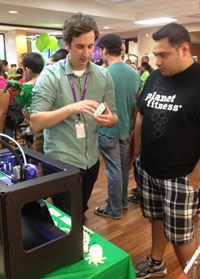
When the Northlake (Ill.) Public Library District wanted to grow its popular graphic novel collection and add a fun element to attract young adults, the staff decided to dream big—really big. As in 9-feet-tall-and-green kind of big.
Staff members launched a crowdfunding campaign in 2013 through the website Indiegogo to raise $30,000 to buy a statue of the Incredible Hulk, a stack of new graphic novels, and new technology, including a 3D printer and an iMac with a drawing pad.
Did the library hit its funding goal with a legendary Hulk smash?
“We didn’t even raise enough money to buy his leg,” says Sharon Highler, the library’s director. “But we reached every goal except the actual money.”
A boxing gym owner in California saw the campaign online and decided to donate his own Hulk statue, a decoration from the premiere of the 2008 movie The Incredible Hulk. A logistics company donated transportation for the massive statue. And with the $4,262 raised from the online campaign, the library was able to buy all the technology it wanted, as well as quite a few graphic novels to boot.
Many of the donations came from the local community, but some were national and even international. Northlake’s unique goal helped it garner press attention, leading to more donations. Highler even got a call from Good Morning America—though nothing aired.
On the other side of the country, the Paonia branch of the Delta County (Colo.) Libraries used the crowdfunding website Kickstarter to raise money for an innovative project: to bring Wi-Fi hotspots to its town of 1,500 residents by using television “whitespace” made available in 2010 after the switch to digital signals.
Paonia was one of six public libraries nationwide selected for the pilot Super Wi-Fi project from the Gigabit Libraries Network, but it was only for a trial period. If the library wanted to keep its Wi-Fi hotspots permanently, it had to purchase the equipment, the total cost of which was $6,000. When a local millage was defeated and the town council didn’t offer the money, John Gavan, the libraries’ technology manager, turned to crowdfunding.
The library had 30 days to raise the needed $4,000, and it succeeded, meeting its goal on January 19. Wi-Fi usage is going up by the week, says Gavan, and the town is very appreciative, especially given the difficulty of getting wireless internet in this rural mountain area. Although most of the donations were local, one large donation arrived from a young man in Africa who had used the library’s internet when he was a student living in Paonia years before.
Both Highler and Gavan say they would consider crowdfunding campaigns again, but they also offer suggestions to other libraries and librarians based on lessons they gleaned from their initial efforts.
Create a campaign. Instead of creating a funding goal, both Highler and Gavan stress the importance of a publicity campaign to help promote a project.
“It’s extremely important to have a really solid plan in place for promotion before you launch,” says Gavan.
Think about how you want the public to perceive the goal and shape your campaign to fit that. Highler says many people were confused about why a library wanted a statue of the Hulk.
“They were asking, ‘Why is the library asking for this much money?’” she says. “The misconceptions made meeting our goal tough.”
Know your website options. Different crowdfunding sites have different rules, limitations, and costs. While Delta County used Kickstarter, Gavan says he and his colleagues will probably consider a different site in the future.
“One issue with Kickstarter is that you have to reach 100% of your goal or you don’t get the money,” he says. “And the fees are pretty hefty. Kickstarter takes 5% and then Amazon payments take another 5%.” Other options may include GoFundMe, Indiegogo, and RocketHub.
Keep the interest up. Once you’ve launched a campaign, it’s important to let people see your progress and ask them to share it with friends and social networks.
“You can’t just launch it and sit back and wait,” Gavan says. “You have to really work it.”
But the work is worth it, according to Highler, especially when it makes expensive projects a possibility.
“We need to be able to provide our community with what they want and what they need,” she says. “Just because we don’t have a lot of money, we can’t say no. This community [of Northlake] isn’t rich, so we have to be very creative with getting the things we want to be able to offer. This was our first effort in doing something really big in order to do that.”


